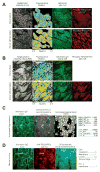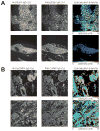Imaging tumour heterogeneity of the consequences of a PKCα-substrate interaction in breast cancer patients
- PMID: 25399560
- PMCID: PMC4259014
- DOI: 10.1042/BST20140165
Imaging tumour heterogeneity of the consequences of a PKCα-substrate interaction in breast cancer patients
Abstract
Breast cancer heterogeneity demands that prognostic models must be biologically driven and recent clinical evidence indicates that future prognostic signatures need evaluation in the context of early compared with late metastatic risk prediction. In pre-clinical studies, we and others have shown that various protein-protein interactions, pertaining to the actin microfilament-associated proteins, ezrin and cofilin, mediate breast cancer cell migration, a prerequisite for cancer metastasis. Moreover, as a direct substrate for protein kinase Cα, ezrin has been shown to be a determinant of cancer metastasis for a variety of tumour types, besides breast cancer; and has been described as a pivotal regulator of metastasis by linking the plasma membrane to the actin cytoskeleton. In the present article, we demonstrate that our tissue imaging-derived parameters that pertain to or are a consequence of the PKC-ezrin interaction can be used for breast cancer prognostication, with inter-cohort reproducibility. The application of fluorescence lifetime imaging microscopy (FLIM) in formalin-fixed paraffin-embedded patient samples to probe protein proximity within the typically <10 nm range to address the oncological challenge of tumour heterogeneity, is discussed.
Figures



Similar articles
-
Resistin, a fat-derived secretory factor, promotes metastasis of MDA-MB-231 human breast cancer cells through ERM activation.Sci Rep. 2016 Jan 5;6:18923. doi: 10.1038/srep18923. Sci Rep. 2016. PMID: 26729407 Free PMC article.
-
Inhibition of ezrin causes PKCα-mediated internalization of erbb2/HER2 tyrosine kinase in breast cancer cells.J Biol Chem. 2019 Jan 18;294(3):887-901. doi: 10.1074/jbc.RA118.004143. Epub 2018 Nov 21. J Biol Chem. 2019. PMID: 30463939 Free PMC article.
-
A novel role for ezrin in breast cancer angio/lymphangiogenesis.Breast Cancer Res. 2014 Sep 18;16(5):438. doi: 10.1186/s13058-014-0438-2. Breast Cancer Res. 2014. PMID: 25231728 Free PMC article.
-
[Advances of the Role of Ezrin in Migration and Invasion of Breast Cancer Cells].Sheng Li Ke Xue Jin Zhan. 2016 Feb;47(1):21-6. Sheng Li Ke Xue Jin Zhan. 2016. PMID: 27424401 Review. Chinese.
-
The cofilin pathway in breast cancer invasion and metastasis.Nat Rev Cancer. 2007 Jun;7(6):429-40. doi: 10.1038/nrc2148. Nat Rev Cancer. 2007. PMID: 17522712 Free PMC article. Review.
Cited by
-
Quantification of HER family receptors in breast cancer.Breast Cancer Res. 2015 Apr 9;17:53. doi: 10.1186/s13058-015-0561-8. Breast Cancer Res. 2015. PMID: 25887735 Free PMC article. Review.
-
Signatures of breast cancer metastasis at a glance.J Cell Sci. 2016 May 1;129(9):1751-8. doi: 10.1242/jcs.183129. Epub 2016 Apr 15. J Cell Sci. 2016. PMID: 27084578 Free PMC article. Review.
-
Macrophage-dependent tumor cell transendothelial migration is mediated by Notch1/MenaINV-initiated invadopodium formation.Sci Rep. 2016 Nov 30;6:37874. doi: 10.1038/srep37874. Sci Rep. 2016. PMID: 27901093 Free PMC article.
-
Estradiol induces bone osteolysis in triple-negative breast cancer via its membrane-associated receptor ERα36.JBMR Plus. 2024 Mar 26;8(5):ziae041. doi: 10.1093/jbmrpl/ziae041. eCollection 2024 May. JBMR Plus. 2024. PMID: 38644978 Free PMC article.
-
HER2-HER3 dimer quantification by FLIM-FRET predicts breast cancer metastatic relapse independently of HER2 IHC status.Oncotarget. 2016 Aug 9;7(32):51012-51026. doi: 10.18632/oncotarget.9963. Oncotarget. 2016. PMID: 27618787 Free PMC article.
References
-
- Ravdin PM, Siminoff LA, Davis GJ, Mercer MB, Hewlett J, Gerson N, Parker HL. Computer program to assist in making decisions about adjuvant therapy for women with early breast cancer. J Clin Oncol. 2001;19:980–991. - PubMed
-
- van’t Veer LJ, Dai H, van de Vijver MJ, He YD, Hart AA, Mao M, Peterse HL, van der Kooy K, Marton MJ, Witteveen AT, et al. Gene expression profiling predicts clinical outcome of breast cancer. Nature. 2002;415:530–536. - PubMed
Publication types
MeSH terms
Substances
Grants and funding
LinkOut - more resources
Full Text Sources
Other Literature Sources
Medical

